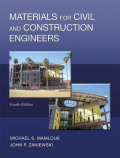
The shape and surface texture of aggregate particles are important for both portland cement concrete and asphalt concrete.
a. For preparing PCC, would you prefer round and smooth aggregate or rough and angular aggregate? Briefly explain why (no more than two lines).
b. For preparing HMA, would you prefer round and smooth aggregate or rough and angular aggregate? Briefly explain why (no more than two lines).
Want to see the full answer?
Check out a sample textbook solution
Chapter 5 Solutions
EBK MATERIALS FOR CIVIL AND CONSTRUCTIO
Additional Engineering Textbook Solutions
INTERNATIONAL EDITION---Engineering Mechanics: Statics, 14th edition (SI unit)
Starting Out With Visual Basic (8th Edition)
Starting Out with Programming Logic and Design (5th Edition) (What's New in Computer Science)
Elementary Surveying: An Introduction To Geomatics (15th Edition)
Fluid Mechanics: Fundamentals and Applications
Thinking Like an Engineer: An Active Learning Approach (4th Edition)
- SOLVE BY NEWTON - RAPHSON METHOD: The equation x³-3x-4=0 is of the form f(x) = 0 where f(1) 0 so there is a solution to the equation between 1 and 3. We shall take this to be 2, by bisection. Find a better approximation to the root.arrow_forwardKindly help to provide answers, elaborate with examples and provide useful links for learning purposes. this is regarding building diagnosis.arrow_forwardpounds of steel need to be purchased for the roof plan a table with various steel types and the quantity needed The colums are 18 feet high and weigh 76 ponds per foot include a structural steel material list for the roof framing planarrow_forward
- Homework: Determine the proportions of the separate aggregates that will give a gradation within the SCRB wearing coarse specified limits for the aggregates and mix composition for highway pavement asphaltic concrete. The table below shows the results of sieve analysis of samples from the materials available. برو Percent by Weight Passing Sieve Designation Retained on Sieve Designation Coarse Aggregate Fine Aggregate Mineral Filler 3/4 in. (19 mm) 1/2 in. 5 ½ in. (12.5 mm) 3/8 in. 35 ¾ in. (9.5 mm) No. 4 38 No. 4 (4.75 mm) No. 10 17 No. 10 (2 mm) No. 40 5 No. 40 (0.425 mm) No. 80 No. 80 (0.180 mm) No. 200 No. 200 (0.075 mm) Total 18 1118 30 35 5 26 35 60 100 100 100arrow_forwardFor the driven pile shown in figure, estimate the allowable capacity by: (a) Tomlinson a-method, (b)Vijayvergia and Focht A-method. Which one of the two methods are more conservative? Qall =? W.T 18.21 kN/m² 930 L=18m Square pile 27.5cm x 27.5cmarrow_forwardWhat is the vertical deflection at joint C of the truss shown? 75 kN 9 m 7 (3000 mm²) (3000 mm²) (2000 mm²) (3000 mm²) (2000 mm²) 100 kN (3000 mm²) H (3000 mm²) (2000 mm²) (2000 mm²) (3000 mm²)B(3000 mm²) C(3000 mm²)D(3000 mm2)5 a. 9.3 mm↓ b. 9.6 mm↓ c. 8.0 mm ↓ d. 9.1 mm↓ 4 at 6 m = 24 m E = 200 GPa Earrow_forward
- INVERSE FROM POINT A TOWARDS POINT B GIVEN THE FOLLOWINGCOORDINATE VALUES: POINT AN=13,163,953.37'E=3,072,227.10' POINT BN=13,163,463.03'E=3,072,129.30' FIND THE FOLLOWING:DISTANCE FROM A TO BNORTH AZIMUTH (NAZ) FROM A TOWARDS BBEARING OF THE LINE FROM A TOWARDS Barrow_forwardFORWARD FROM POINT B TO POINT A GIVEN THE FOLLOWING: POINT BN=13,163,463.03'E=3,072,129.30' DIRECTION FROM B TO A (NAZ)=276.07529° DISTANCE FROM B TO A = 10.00'arrow_forwardA cheetah is crouched 20 m to the east of an observer. At time t = 0 s, the cheetah begins to run due east toward an antelope that is 50 m to the east of the observer. During the first 2.0 s of the attack, the cheetah's coordinate x varies with time according to the equation x = 20 + 5t?. (a) Find the cheetah's displacement between t1 = 1.0 s and t2 = 2.0 s. (b) Find its average velocity during that interval. (c) Derive an expression for the cheetah's instantaneous velocity as a function of time, and use it to find Vy at t = 1.0 s and t = 2.0 s.arrow_forward
- Write at least 20 words for vocabulary and 10 verbs .for simple present, past, and past participlesarrow_forwardCan you compute the Panel Board Management while using the Lighting and Power Layout Plan as the base for it? The attached Panel Board Management picture is just an example. ps. not graded, I just want to know how to compute it based on a planarrow_forwardMake Sure the attached pic is correct, because the answer in mannings equation is wrong. Can you design a (Open Channel): -Most Efficient Section (Rectangular Shape) -Cost Estimate -Structural Analysis Design Requirements: Bed Slope= 1:1500 Manning's (n)= 0.015 Discharge: Q= 18 m^3/sarrow_forward
 Fundamentals of Geotechnical Engineering (MindTap...Civil EngineeringISBN:9781305635180Author:Braja M. Das, Nagaratnam SivakuganPublisher:Cengage Learning
Fundamentals of Geotechnical Engineering (MindTap...Civil EngineeringISBN:9781305635180Author:Braja M. Das, Nagaratnam SivakuganPublisher:Cengage Learning Traffic and Highway EngineeringCivil EngineeringISBN:9781305156241Author:Garber, Nicholas J.Publisher:Cengage Learning
Traffic and Highway EngineeringCivil EngineeringISBN:9781305156241Author:Garber, Nicholas J.Publisher:Cengage Learning Solid Waste EngineeringCivil EngineeringISBN:9781305635203Author:Worrell, William A.Publisher:Cengage Learning,
Solid Waste EngineeringCivil EngineeringISBN:9781305635203Author:Worrell, William A.Publisher:Cengage Learning, Materials Science And Engineering PropertiesCivil EngineeringISBN:9781111988609Author:Charles GilmorePublisher:Cengage Learning
Materials Science And Engineering PropertiesCivil EngineeringISBN:9781111988609Author:Charles GilmorePublisher:Cengage Learning Construction Materials, Methods and Techniques (M...Civil EngineeringISBN:9781305086272Author:William P. Spence, Eva KultermannPublisher:Cengage Learning
Construction Materials, Methods and Techniques (M...Civil EngineeringISBN:9781305086272Author:William P. Spence, Eva KultermannPublisher:Cengage Learning Steel Design (Activate Learning with these NEW ti...Civil EngineeringISBN:9781337094740Author:Segui, William T.Publisher:Cengage Learning
Steel Design (Activate Learning with these NEW ti...Civil EngineeringISBN:9781337094740Author:Segui, William T.Publisher:Cengage Learning





